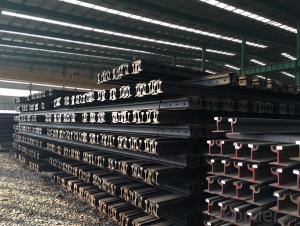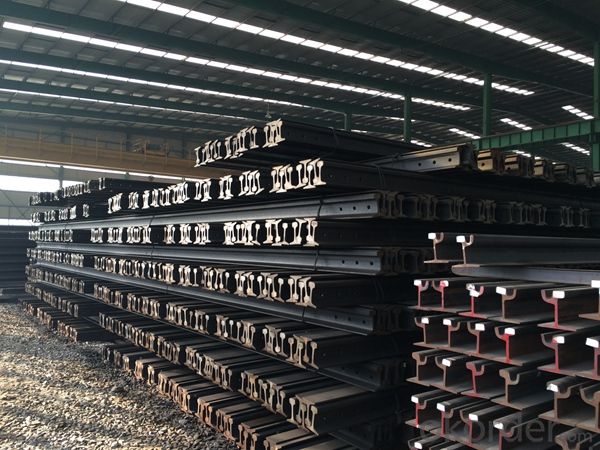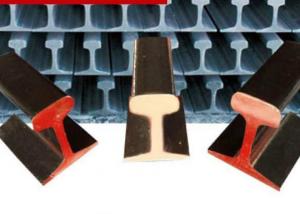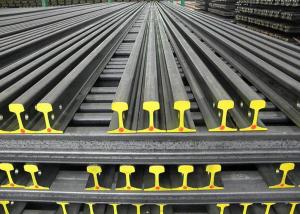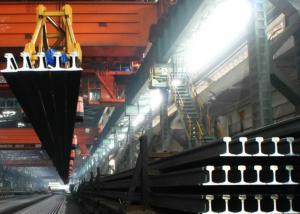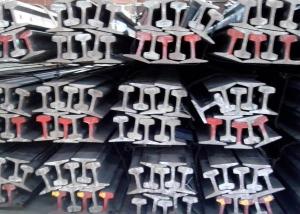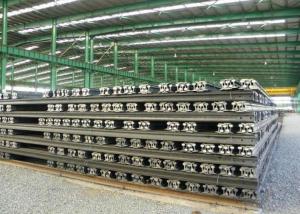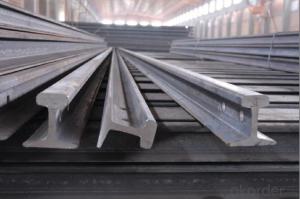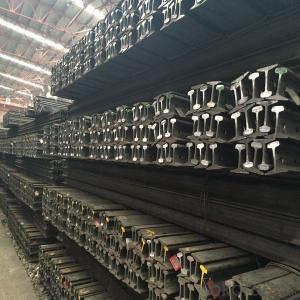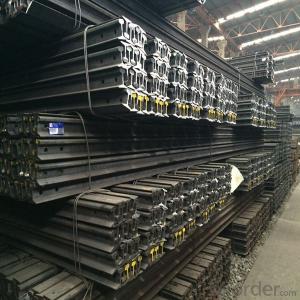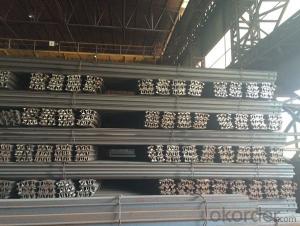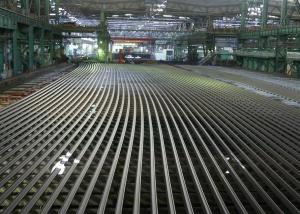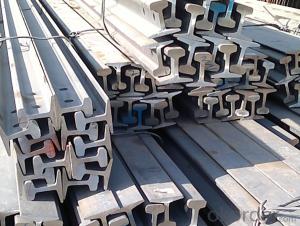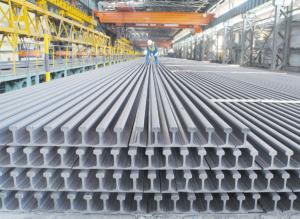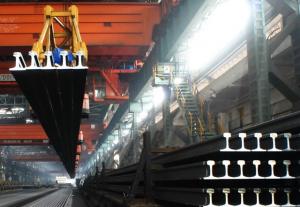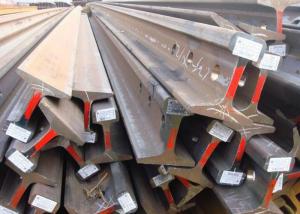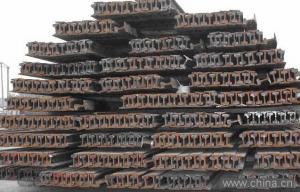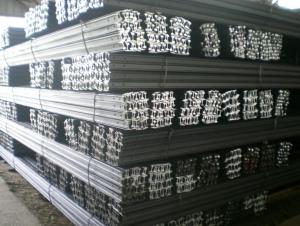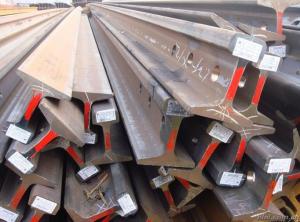Hot Rolled Light Steel Rail for Warehouse ,Minas, Structures
- Loading Port:
- Tianjin
- Payment Terms:
- TT or LC
- Min Order Qty:
- 25 m.t.
- Supply Capability:
- 2000000 m.t./month
OKorder Service Pledge
OKorder Financial Service
You Might Also Like
Specifications of Hot Rolled Light Steel Rail for Warehouse ,Minas, Structures
Product Name: High Quality Steel Rail
Production Standard: GB, AREMA, JIS, DIN, EN, UIC, BS, etc.
Grade: Q235B, 55Q, 900A, 1100A, 50MN, U71MN, R260.
Place of Origin: China
Length: 6M-24M according to the requriements of the customers.
Grade | Element(%) | ||||
C
| Mn | S
| P
| Si
| |
55Q
|
0.50—0.60 |
0.70—1.00 |
≤0.050 |
≤0.045
|
0.15-0.35
|
Applications of Hot Rolled Light Steel Rail for Warehouse ,Minas, Structures
Light rail is mainly used in forest region, mines, factories and construction sites laid of the place such as temporary transport line and light motorcycles with line.
Heavy rail is suitable for the laying of main trunk line of the curves and the orbit of the tunnel can also be used for tower crane and other crane track.
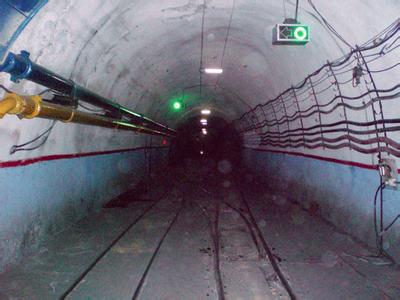
Packaging & Delivery of Hot Rolled Light Steel Rail for Warehouse ,Minas, Structures
1. Packing: it is nude packed in bundles by steel wire rod
2. Bundle weight: not more than 3.5MT for bulk vessel; less than 3 MT for container load
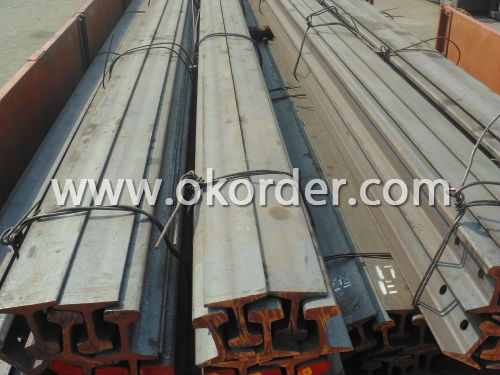
3. Marks:
Color marking: There will be color marking on both end of the bundle for the cargo delivered by bulk vessel. That makes it easily to distinguish at the destination port.
Tag mark: there will be tag mark tied up on the bundles. The information usually including supplier logo and name, product name, made in China, shipping marks and other information request by the customer.
If loading by container the marking is not needed, but we will prepare it as customer request.
4. Transportation: the goods are delivered by truck from mill to loading port, the maximum quantity can be loaded is around 40MTs by each truck. If the order quantity cannot reach the full truck loaded, the transportation cost per ton will be little higher than full load.
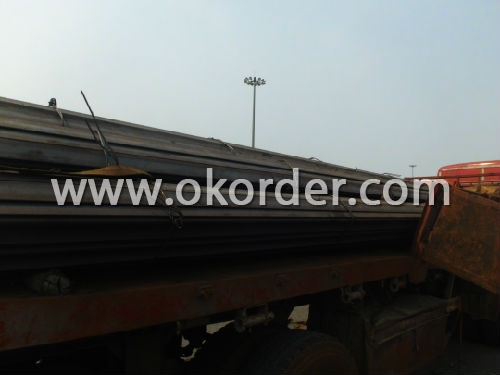
5. Delivered by container or bulk vessel
6. Delivery Time: All the Hot Rolled Steel Rail will be transpoted at the port of Tianjin, China within 30 days after receiving the advance payment by T/T or the orginal L/C at sight.
7. Invoicing on theoretical weight or actual weight as customer request
8. Payment terms: 30% advance payment by T/T, 70% payment against the copy of the B/L; 100% L/C at sight, etc.
Inspection of Hot Rolled Light Steel Rail for Warehouse ,Minas, Structures
We will send the MTC of the factory to the clients directly which contains the anlisis of the heat, chemiqual composition, phisical characteristicas, etc.
And our inspectors will arrive at the factory to meke the inspection of the size, length, weight and quantity before the transportation from the factory.
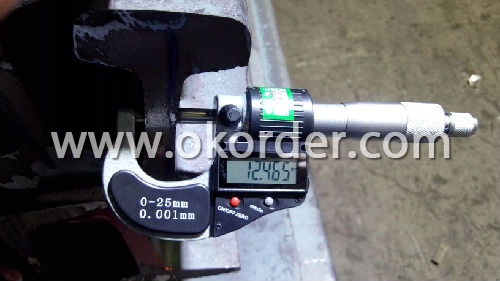
FAQ:
Q1: Why buy Materials & Equipment from OKorder.com?
A1: All products offered byOKorder.com are carefully selected from China's most reliable manufacturing enterprises. Through its ISO certifications, OKorder.com adheres to the highest standards and a commitment to supply chain safety and customer satisfaction.
Q3: What is the normal tolerance of Hot Rolled Mild Steel Angle Beams for Structures and for Buildings?
A3: Normally 3%-5%, but we can also produce the goods according to the customers' requests.
Q3: How soon can we receive the product after purchase?
A3: Within three days of placing an order, we will begin production. The specific shipping date is dependent upon international and government factors, but is typically 7 to 10 workdays.
- Q: Are steel rails suitable for heavy haul rail systems?
- Yes, steel rails are suitable for heavy haul rail systems. Steel is a commonly used material for rail tracks in heavy haul rail systems due to its high strength, durability, and resistance to wear and tear. Heavy haul rail systems typically transport large and heavy loads over long distances, and steel rails can effectively withstand the immense weight and stress exerted by these loads. Steel rails also have excellent load-bearing capabilities, allowing them to support the heavy locomotives and rolling stock used in heavy haul operations. Additionally, steel rails can be designed and manufactured to meet specific requirements, such as higher strength or enhanced resistance to fatigue, making them suitable for the demanding conditions of heavy haul rail systems. Overall, steel rails provide the necessary stability and reliability to ensure the safe and efficient operation of heavy haul rail systems.
- Q: What are the different methods of fastening steel rails to sleepers?
- There are several different methods of fastening steel rails to sleepers. Some common methods include using clips or clamps, spikes or screws, and resilient fastenings. These methods secure the rails tightly to the sleepers, providing stability and ensuring the safe and efficient operation of railways.
- Q: Are steel rails prone to buckling under extreme heat?
- Yes, steel rails are prone to buckling under extreme heat.
- Q: Can steel rails be used for inclined or steep gradient tracks?
- Indeed, inclined or steep gradient tracks can utilize steel rails. Renowned for their robustness and longevity, steel rails prove themselves compatible with diverse railway track types, including those with sharp inclines. The exceptional tensile strength of steel empowers it to endure the immense weight and force exerted by trains, even when traversing uphill or downhill slopes. Moreover, the sleek surface of steel rails enhances traction and minimizes the likelihood of slippage, guaranteeing secure and effective train operations on inclined tracks. Consequently, steel rails emerge as the favored option for constructing railways on gradients or inclines.
- Q: Can steel rails be used in railway systems with heavy traffic?
- Certainly! Steel rails have the potential to be utilized in railway systems that experience substantial traffic. Due to their resilience, potency, and capacity to endure immense loads, steel rails are frequently employed in railway systems across the globe. They are specifically engineered to manage heavy traffic and can endure the weight of trains, even in bustling and high-traffic regions. Moreover, steel rails possess a resistance to deterioration and a lengthier lifespan in comparison to alternative materials, rendering them suitable for railway systems with heavy traffic. Additionally, steel rails demand minimal effort to maintain and can be readily repaired or replaced as necessary, thus ensuring the secure and efficient operation of the railway system.
- Q: How are steel rails affected by changes in train axle loads?
- Train axle loads have a significant effect on steel rails. The weight that each axle applies to the rails is referred to as the axle load. When these loads increase, they place additional stress on the steel rails, which can have various consequences. One immediate consequence of increased axle loads is greater wear and tear on the rails. The higher the axle loads, the more pressure is exerted on the rails, causing them to experience increased friction and abrasion. Over time, this constant pressure can lead to rail wear, resulting in deformation and even cracks on the rail surface. Furthermore, higher axle loads can also lead to increased rail deflection. Deflection occurs when the rail bends or flexes under load. When the axle loads are heavier, the rails are more likely to deflect, which can result in an uneven distribution of the load across the rail surface. This uneven distribution can further worsen wear and tear and potentially lead to rail deformation or failure. Another important factor that is affected by changes in axle loads is fatigue. As the axle loads increase, the cyclic loading on the rails becomes more intense. This cyclic loading, combined with the constant stress from the train's weight, can cause fatigue cracks in the steel rails. If these cracks are not detected and repaired promptly, they can propagate and eventually lead to rail failure. Additionally, changes in train axle loads can also have an impact on the overall stability of the track. Higher axle loads increase the risk of track settlement and misalignment. Settlement occurs when the track sinks or shifts due to excessive pressure, which can cause irregularities in the track. Misalignment can occur if the rail shifts or twists under heavy axle loads, affecting the track's geometry and compromising its stability. In conclusion, changes in train axle loads have a significant impact on steel rails. Increased axle loads result in higher wear and tear, increased rail deflection, fatigue cracks, and potential stability issues. Therefore, it is crucial for railway operators and maintenance teams to carefully monitor and manage axle loads to ensure the long-term integrity and safety of the rail infrastructure.
- Q: How are steel rails protected from damage caused by rockfalls?
- Various measures are implemented to protect steel rails from rockfall damage. One commonly employed method involves the use of rockfall protection barriers or fences, typically constructed from durable materials like steel. These barriers are strategically positioned along the railway tracks in areas prone to rockfalls, acting as a physical blockade to prevent rocks and debris from reaching the rails and causing harm. In addition, rockfall catchment systems are frequently installed in high-risk areas. These systems consist of nets, fences, or wire meshes placed on the slopes above the railway tracks. Their purpose is to catch falling rocks, effectively stopping them from reaching the rails. Once captured, the rocks can be safely removed, minimizing the risk of damage to the steel rails. In certain instances, rockfall protection tunnels or galleries are constructed to safeguard the railway tracks from rockfall hazards. These structures, typically made of reinforced concrete, are built in areas with significant rockfall risks. By redirecting or containing falling rocks away from the rails, they provide an added layer of protection. Regular inspections and monitoring play a crucial role in safeguarding steel rails from rockfall damage. Trained personnel thoroughly examine the slopes adjacent to the railway tracks, identifying any potential rockfall hazards. This early detection allows for prompt implementation of mitigation measures, such as removing loose rocks or stabilizing unstable slopes. Moreover, advanced technologies like radar systems, geotechnical monitoring instruments, and drones are increasingly utilized to detect and monitor real-time rockfall risks. These technologies provide valuable data and timely warnings, enabling authorities to take immediate action in protecting the steel rails and ensuring the safety of the railway infrastructure. In summary, a combination of physical barriers, catchment systems, tunnels, regular inspections, and advanced monitoring technologies work together to safeguard steel rails from rockfall damage. These measures are essential in maintaining the integrity and safety of railway tracks, guaranteeing uninterrupted train operations.
- Q: How are steel rails protected against damage caused by vegetation growth?
- Steel rails are protected against damage caused by vegetation growth through regular maintenance practices such as trimming and spraying herbicides to prevent plant growth near the tracks. Additionally, some rail operators employ specialized equipment like vegetation control trains or use barriers like weed mats to minimize vegetation encroachment and ensure the safe and smooth functioning of the rails.
- Q: How do steel rails contribute to reducing maintenance costs in railways?
- Steel rails contribute to reducing maintenance costs in railways in several ways. Firstly, steel rails are highly durable and have a longer lifespan compared to other materials. This means that they require less frequent replacement, resulting in lower maintenance costs over time. Secondly, steel rails have high resistance to wear and tear, making them less prone to damage from heavy train traffic. This reduces the need for frequent repairs and replacements, thereby lowering maintenance expenses. Additionally, steel rails provide a smooth and stable surface for train wheels, reducing friction and minimizing the risk of derailments. By ensuring a safe and efficient operation of trains, steel rails help to prevent accidents and subsequent costly repairs. Lastly, steel rails are resistant to extreme weather conditions, such as temperature changes and moisture, which can cause degradation of other materials. This durability reduces the need for constant maintenance and repairs, resulting in further cost savings. Overall, the use of steel rails in railways significantly contributes to reducing maintenance costs by providing a long-lasting, low-maintenance, and safe infrastructure for trains to operate on.
- Q: What are the common maintenance practices for steel rails?
- Common maintenance practices for steel rails include regular inspections to identify any defects or wear, cleaning to remove debris and prevent corrosion, lubrication to reduce friction and wear, and periodic reprofiling or grinding to maintain the proper rail profile. Additionally, rail fasteners, joints, and connections are regularly checked and repaired if necessary.
Send your message to us
Hot Rolled Light Steel Rail for Warehouse ,Minas, Structures
- Loading Port:
- Tianjin
- Payment Terms:
- TT or LC
- Min Order Qty:
- 25 m.t.
- Supply Capability:
- 2000000 m.t./month
OKorder Service Pledge
OKorder Financial Service
Similar products
Hot products
Hot Searches
Related keywords
